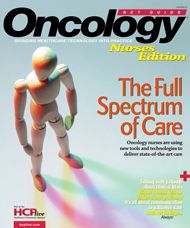Winter Fitness
Cold days should not prevent anyone from maintaining their outdoor fitness routines. People with cancer, in particular, can still enjoy the fresh air and physical activity, so long as they are prepared.
Cold days should not prevent anyone from maintaining their outdoor fitness routines. People with cancer, in particular, can still enjoy the fresh air and physical activity, so long as they are prepared. Below is a list of suggestions to discuss with your cancer patients on how they can remain physically active while safely enjoying their favorite winter activities.
Prepare physically and mentally
Winter activities that require skill, coordination, and endurance (eg, skating, skiing, sledding) may not be best for patients who are either weak from cancer treatment or surgery, or who are physically deconditioned. However, walking outside on a neighborhood street or groomed trail is safe. Endurance can be challenged by increasing the pace or walking up a hill. For patients who are actively receiving treatment, fatigue and lack of endurance may prohibit prolonged periods of walking; tell them to plan walks for their peak energy time. At high altitudes, anemia-associated symptoms may worsen. Patients with cancer should also be aware of icy patches and uneven pavement, because weak bones caused by treatment or disease can lead to terrible injuries. Patients should aim to take a walk for a few minutes a day at an intensity that allows them to breathe and speak, while increasing or decreasing the amount of walking time as tolerated or dictated by the treatment regimen. On days when the weather is too cold or inclement, patients should seek such indoor physical activities as walking in the house or at a shopping mall, or working out at a health club.
Ensure that enough is enough
Patients undergoing cancer treatment may tire easily, so a respectful pace is necessary. They should stay outdoors for shorter periods and remain on marked trails and walkways near transportation and other people. Tell patients that they should carry a small flashlight, cell phone, identification, snacks, and water while walking on or off groomed trails. It is also important that patients tell their neighbors and family where they are going, if walking alone, in case of an emergency.
Prevent damage from the cold
Talk to your patients about the importance of applying sunscreen with SPF 30 or higher—and reapplying every two hours—to their face, ears, and body areas that will be exposed to direct sunlight, especially those who are being treated for or have a history of skin cancer. Skin cancer patients should speak with their oncologist about proper skin protection protocol for the winter. Patients experiencing weight loss from treatment or disease need to pay close attention to their body temperature and dress accordingly. Recommend that they wear layers for warmth and protection and to accommodate body temperature changes during activities. Because skin can get irritated from perspiration during radiation therapy, patients should wear moistureabsorbing underclothing to wick perspiration away from the skin. To prevent frostnip, patients should also wear gloves and socks, a face mask or scarf wrapped around the nose and mouth to warm the inspired air, and a hat, since up to 40% of heat loss occurs through the head. Wearing appropriate footwear that ensures warmth, dryness, and ankle support is extremely important. For those with peripheral neuropathies or nerve damage from immunotherapy, chemotherapy, or surgery, make sure that boots and other equipment do not impede circulation, which can lead to skin ulceration and breakdown. Because these patients may not be able to feel tingling in the fingers, toes, nose, and earlobes, they are at risk for frostnip. Limiting time outdoors and protecting the skin with warm clothing will also help prevent this. Suggest to patients that they wear sunglasses to decrease glare and protect from UV rays, and that their sunglasses have side protection, particularly with snow exposure.
Refuel frequently
Explain to patients the importance of dietary selection for winter activities. They should eat foods that consist of carbohydrates (55%-65%), protein (10%—15%), and fat. Patients should carry foods that help with nausea, should this occur; trail mix is a healthy choice. Cold blunts thirst, so patients will feel less thirsty despite evaporative water loss. Those on chemotherapy and radiation therapy should be even more mindful of fl uid intake and should consume fluids frequently. Everyone should be well hydrated before, during, and after outdoor activities and should not wait until they feel thirst to drink a beverage. Following these fitness tips will allow patients to still enjoy participating in winter activities with their friends and family.
Lisa Marie Bernardo, PhD, MPH, RN, HFI, 200-RYT is an associate professor at the University of Pittsburgh School of Nursing. She is a 200-hours registered yoga teacher through the Yoga Alliance.
References
ACSM’s Exercise Management for Persons with Chronic Diseases and Disabilities (2nd Ed)
American Academy of Orthopaedic Surgeons
American College of Sports Medicine
Cancer Fitness: Exercise Programs for Patients and Survivors
Schwartz, A. (2003). Cancer. In: J. L. Durstine & G.E. Moore (Eds).
